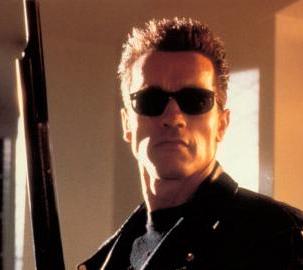| It
was purported that George Lucas held off on the second Star
Wars trilogy until computer generated effect technology was
advanced enough to address his ambitions for the series. The result
however, was not up to the caliber that eager fans of the groundbreaking
original trio had longed for. What they got was the loquacious,
ebonic jabber of Jar Jar Binks, the big rubbery, computer spawned, humanoid duck, who
seemed unreal onscreen, though more alive than some of his wooden
human counterparts (Hayden Christensen and Natalie Portman). Worse
however, was the preposterous scene where Binks and his ducky comrades
battled a phalanx of droid storm troopers. There’s not a human
in sight and the entire battle sequence looks like a cheesy animation
project hacked out by a teen on the household PC.
Jar Binks, the big rubbery, computer spawned, humanoid duck, who
seemed unreal onscreen, though more alive than some of his wooden
human counterparts (Hayden Christensen and Natalie Portman). Worse
however, was the preposterous scene where Binks and his ducky comrades
battled a phalanx of droid storm troopers. There’s not a human
in sight and the entire battle sequence looks like a cheesy animation
project hacked out by a teen on the household PC.
That
was seven years ago. Lucas’s endeavor sparked talk about films
being made without actors or sets, where the environment and players
would simply be digital renderings. Final Fantasy
(2001) was one of the first to make that leap and Sky Captain
and the World of Tomorrow (2004), was unique in its way of
pasting live actors into an ‘other world,’ yet neither
movie made audiences or filmmakers forget thespian craft and live
flesh and blood emoting.
That
said Andy Serkis did deliver knockouts as Gollum in the Lord
of the Rings series, and later as King Kong in Peter
Jackson’s 2005 remake of the classic ape yarn. Also noteworthy
were the interpolated-rotoscoping techniques that Slacker director
Richard Linklater applied to Waking Life (2001) and A
Scanner Darkly (2006), which for all intents and purposes transformed
live action film into a trippy 2D cartoon.
Then
in 2004, Robert Zemeckis dropped The Polar Express and
“performance capture” animation on audiences. The rich
3D rendering proved as wondrous as the enchanting children’s
Christmas story the film was based on. As the titled train’s
conductor Tom Hanks was transmuted into a glabrous, colorized version
of himself. What’s on screen, like Serkis as Gollum, isn’t
really Hanks. Essentially the actor provides the voice, likeness
and physical movements for the character. The computer sucks in
all this information, allowing for further input from the director
and animators, and after some intense CPU crunching, spits out the
synthetic onscreen doppelganger.
With
his latest, the retelling of the Olde English poem, Beowulf,
Zemeckis takes “performance capture” technology to the
next level. The normally portly Ray Winston is transformed into
the Adonis chiseled hero of the title, and the first time we see
a nearly nude Anthony Hopkins as King Hrothgar, it takes a while
to figure out it’s not the Oscar winning actor in the flesh,
but his avatar. Of course, in Winstone’s case, a young, more
athletic stallion was used to get much of the Beowulf character’s
physicality up on the screen. The grit and real world quality of
the experience is much improved from The Polar Express.
But even so, as you are hurled into the teeth of the Zemeckis’s
animated wizardry, there’s something not quite genuine enough
to make you believe that it’s something more than a Pixar
production or an Entertainment Arts videogame straining its steroid
injected hardest to emulate carbon life forms. It nags you. It’s
not readily apparent as to why, but as the story builds and you
see the characters in close-ups more and more, it hits you. The
eyes have it.
Quint’s
description of a shark’s eyes in Jaws, as being “cold
and lifeless” is dead on. How many times have you ever walked
through a Best Buy and can’t tell if the basketball or football
game unfurling on the gigantic flat screen before you is an actual
flesh and blood contest or digital fantasy? As you walk closer,
flip-flopping your conclusion, the truth becomes clear. The eyes
give it away. They don’t move, and when they do, it’s
not natural.
When
you’ve got a warrior battling trolls and dragons, or a legion
of elves frolicking about the North Pole, audiences come to the
screen with a ready willingness to suspend disbelief. That’s
the nature of fantasy. Zemeckis’s slick chicanery would not
wash per se if Atonement were produced with “performance
capture.” When it comes to drama or something deep felt and
visceral, people want to see the characters pour themselves out
on screen. They want real tears, real blood and the tortured, twisted
lines on one’s face as tragedy befalls them. It’s an
emotional moment that viewers want to connect with and no computer
in Hollywood or Silicon Valley can provide that. Not today.
It
is also the fantastical that has garnered Serkis with such opportunity
for success. In the afore cited examples he’s playing a nonhuman
life form that exists only in the recesses of the creator’s
mind. And with advancements in technology, the rendering that the
computers can cook up today is far superior than most of the hokey incarnations staged
yesteryear—no disrespect intended for James Cameron’s
magic in the Terminator series or the dinos in Jurassic
Park and I would make the argument that Lucas did better with
the first trilogy, than the second if we’re talking simply
about transporting and audience to a world that is believable.
up today is far superior than most of the hokey incarnations staged
yesteryear—no disrespect intended for James Cameron’s
magic in the Terminator series or the dinos in Jurassic
Park and I would make the argument that Lucas did better with
the first trilogy, than the second if we’re talking simply
about transporting and audience to a world that is believable.
With
such leaps in technology it seems almost inevitable that some day
a computer will be able to suck up all Jack Nicholson’s performances
from an online film archive and return his artificial likeness onscreen,
in any setting or any form. Imagine having the Jack who
consumed the screen in One Flew Over the Cuckoo’s Nest
on tap for any and all future productions? Such a resource
might be too much of a good thing; a preverbal bottomless box of
chocolates.
No,
audiences need new blood. Jack will remain enshrined in his rightful
cinematic pantheon and viewers will continue to require a deep emotional
connection from films embodying the challenge of the human spirit
in the material world. That’s not to discount the power of
computers in filmmaking, they’ll still fill in and elevate
those bump-in-the-night, deep-space and future world thrillers to
a higher level of “near reality.”
-- T.
B. Meek
|






